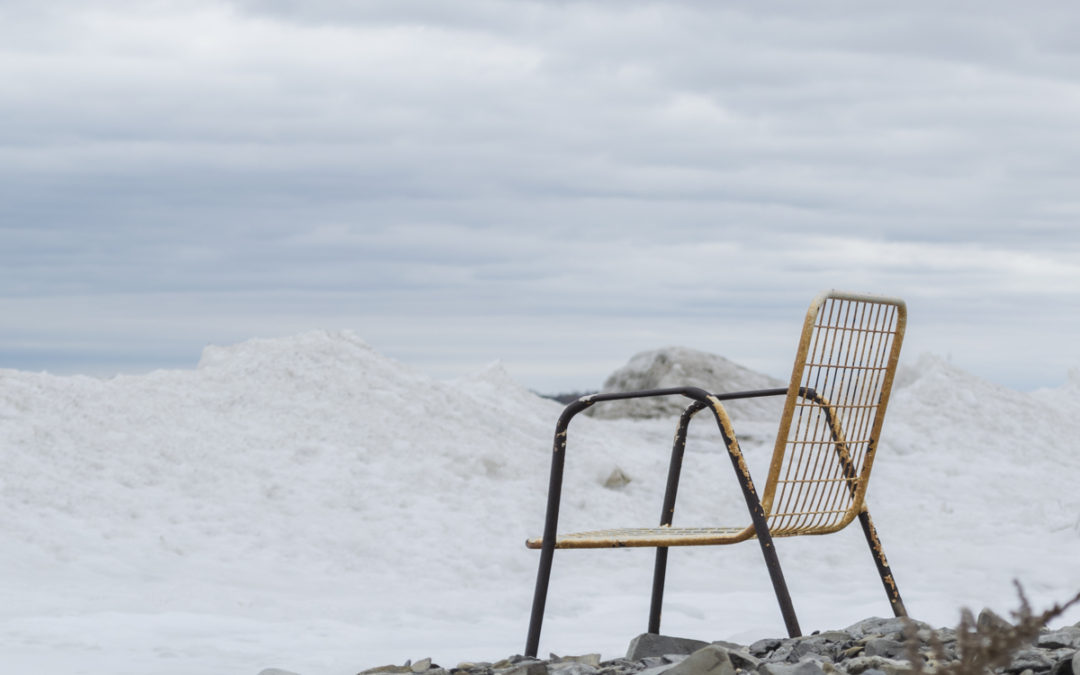
by David Brandy | Jul 3, 2017 | David Brandy, Still Life, Stories, Storyteller, You Are Grryo
What you are about to read are disparate and fictional short stories I have written to coincide with images that are part of a series of photographs of mine entitled “Empty Seats”. The series embraces the enigma of everyday objects that are specifically created by and for human beings, yet they are filled with emptiness, loneliness and a longing for human presence…

Alone and abandoned, the once proud turquoise chair finds itself frozen by the side of the road. Mere hours earlier the chair had enjoyed a life of abandoned inclusion in the warm garage of a lakeside vacation home owned by a caring family. Strategically placed next to the riding mower and directly across from the red 10-drawer tool chest, this once elegant and much sought after chaise was complacently secure in its retirement inside the cozy dry garage.
On a frigid January day with no forewarning, the teenage children from the family burst into the garage with orders to clean it out. One by one, the familiar items in the garage were carted out by the teens and left indignantly at the end of the driveway in a heap of despair. When the eldest daughter picked up the turquoise chair, it knew the end was near and its destiny would be on top of the heap on the driveway to await a final resting place in the local landfill. But all of a sudden the girl walked across the driveway to the side of the icy road in front of the property and plunked the chair into the snow bank.
Alone and facing the elements for the first time in its storied life, the chair sunk into the wet, damp snow and sighed a deep, remorseful sigh, knowing that for now it had been saved from imminent death, but, that from this moment forward, life as it had known it would succumb to a daily ritual of growing rot, mold and mildew. The horror. The horror.

William sat alone mourning his dead wife for nearly an hour. Looking up, he realized that every person who had come to witness the burial had vanished. Suddenly he felt the weight of knowing that he was truly alone now for the first time in 36 years. He rose sobbing and walked away, leaving behind a hard damp bench, a haunting headstone and the cold lifeless body of his beloved Jacqueline, now six feet under ground.

It was not always an “art piece”.
It first held court upon the front deck of a beautiful cottage situated high above a lake. Sturdy and strong with a brilliant coating of white paint, it beckoned family members and newcomers alike to sit in comfort on its reclining seat with big wide arm rests and gaze upon the magnificent view.
But time and the elements are not kind to a Muskoka chair. Today it sits on the slope that faces the lake below the cottage deck. It is in the perfect spot to be seen by those passing by in a boat or lazing carefree on the dock.
This chair comes from a strong breed. In its retirement it may be willing to sit alone in the cool shade of a Hemlock tree all summer or hibernate throughout the winter under a blanket of snow, but it is far from the end of its life. It can no longer support the full weight of today’s generation of cottage-goers, but it can support the weight of their fond memories.
After all, art is all about memories.

Derek forgot his raincoat and gloves – again!
This is a frequent occurrence – too frequent. In fact, Derek has been forgetting a lot of things lately. His doctor has hinted at early-onset dementia. But at 53 years old, Derek doesn’t want to hear about such things. After all, as he said to his doctor, “I have a wife and two daughters to take care of for Christ’s sake!”
Derek has worked at the scrap iron yard since he was 18 years old. He never saw the point in going to university. He wanted to start making money at an honest job right out of high school.
Eating his lunch at the company picnic table every day for 35 years is one of the small pleasures in Derek’s life. He loves to sit out there rain or shine. It makes him feel alive. If he happened to have left his raincoat on the bench again, so be it. He’ll grab it tomorrow, if he remembers.
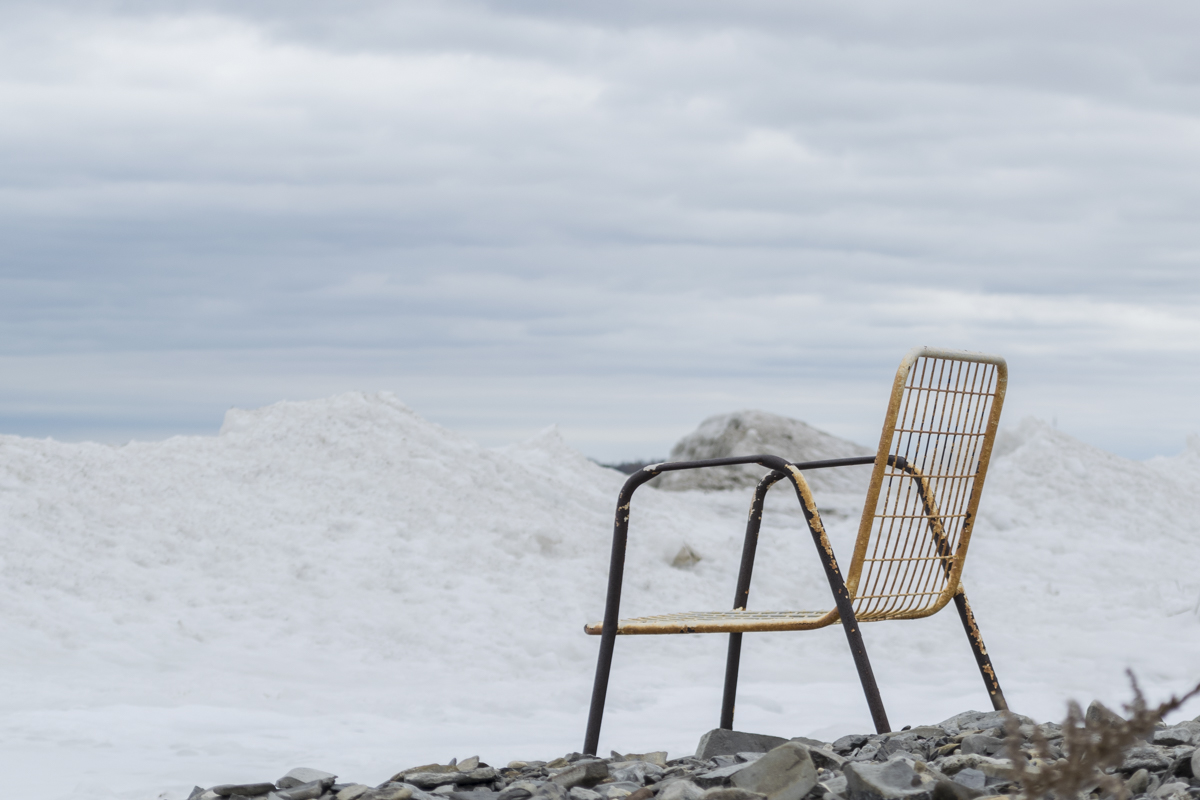
Nathalie came upon this oddly placed chair on a brisk winter’s day. It was just sitting there upon the rocks inviting her to take a break from walking her dog. “How wonderful,” Nathalie thought. “I could use a short rest.”
Nathalie sat down on the cold steel bars of the chair. At first it was a welcome respite. “Life is good,” she said out loud for no one to hear. The view was spectacular. Large ice dunes had formed along the beach and provided a scenic panorama. The sky was painterly in its glorious blue-gray striations. The air was fresh and clear. No sound could be heard except the lapping of the waves under the ice and the breathing of her tired old dog.
Then the cold hard reality hit her. A pair of thin blue jeans was the only thing that separated Nathalie’s butt from the cold hard steel. Immediately her respite was interrupted as she realized her moment of Zen was going to leave a mark!
Hoping no one was watching, she rubbed her hands across the ridges of the grid-like imprint on her frozen behind. She called her dog and briskly walked toward her car, murmuring under her breath, “Damn winter!”

Drenched and near death, men, women and children from a land far away washed up on the shore one by one, clinging to their precious life rings. Stumbling upon the beach they realized they had survived their flight from genocide in their homeland and that they were now miraculously safe.
Many of their friends and family members were not so lucky. They were not able to find a life ring to cling to as their small boat capsized in the stormy and frigid water. They were now lost forever.
The survivors who made it to this desolate beach took a moment to stack their “life” rings next to the empty benches on the frozen sand. They created a makeshift memorial to honour those who died trying to reach freedom. For this exhausted and frightened group of refugees it was of paramount importance in their dire moment of survival to somehow pay tribute to their lost loved ones.
They turned and walked away into the warm and open arms of those who would help them begin a new life in a new land.

The greatest Luchador in all of Mexico has hung up his mask. He was always a bit of a swinger.

The train came to a stop at Broadview Station. When the man sitting across from me got up to leave the train he crumpled up the newspaper he was reading and dropped it on the floor. As the man exited the train, I noticed the word “hate” in the headline on the page facing me.
“You know what I hate?” I thought. “I hate litter!”
No, wait, I hate the act of people littering. Yes, “hate” is a strong word. In my opinion those who litter deserve to have a strong word thrown at them.
Subway litter. Roadside litter. Sidewalk litter. Litter in the countryside. Litter on the beach. Litter in our lakes, rivers and oceans.
Today litter is everywhere on this Earth and it’s repugnant to me. It’s the ultimate sign of utter laziness in a human being. And it’s ignorant as well. The person who litters is blatantly saying, “I don’t give a crap about this Earth.”
Well I do give a crap about our Earth. I care deeply about stewardship and preserving the only land and water we have to live upon. We are choking it and I don’t believe it can come up for air any longer without some emergency measures. We need to release the Earth from the chokeholds of litter and pollution.
We need to “hate” litter and the actions of those who create it.

I was walking through my neighbourhood park that contains one lone blue bench. I saw a photographer hurrying to set up his camera and tripod across from the bench, as the sky grew ever darker with ominous storm clouds overhead.
Two teenage boys came walking across the park toward the bench, unseen by the photographer who was looking through his viewfinder.
The two boys looked to be up to no good, so I hung close by in case there was trouble brewing. They approached the photographer and one of them said, “Hey dude, you gonna be long ‘cause we wanna sit on the bench?”
The photographer looked up and said, “Just give me ten minutes please. I drove for an hour to get here to get this shot.”
“Are you kidding me?” the boy said. “You drove an hour to take a picture of that!”
“Ya, I did.” said the photographer.
“What a waste of time.” the boy replied.
I laughed out loud and walked away as the photographer hurried to get his shots. The boys wandered off to sit on a large boulder in the park and as I walked past them they lit up a joint. I turned to look back when I heard the photographer shout to the boys, “It’s all yours now guys.”
The boys never moved off the rock.

He had been officially “homeless” for nearly a year. This outdoor encampment perched next to an abandoned railway track was his “home” now. It contains a tarp to sleep under, a cane chair, an end table and a tiny garden with kitschy decorations.
His kingdom is deliberately designed and immaculately ingenious. The squatter got up out of the chair, grabbed one of the many pairs of work gloves he had collected and walked away.
Off he went to who-knows-where. But one thing is certain. He has a place to come home to, be it ever so humble.

Where do lifeguards go in winter?
Do they fly south? Maybe they go work at a tanning salon. Or perhaps they just find an indoor pool to guard.
These brave souls whose job it is to protect us frolicking sunbathers, suddenly vanish in September not to be seen again for another nine months.
Where DO lifeguards go in winter? It’s surely one of life’s guarded mysteries.
My photographs and words can be found at:
www.davidbrandyphotography.com
Instagram: @davidbrandyphotography
Twitter: @dbrandyphoto
FaceBook: www.facebook.com/davidbrandyphotography
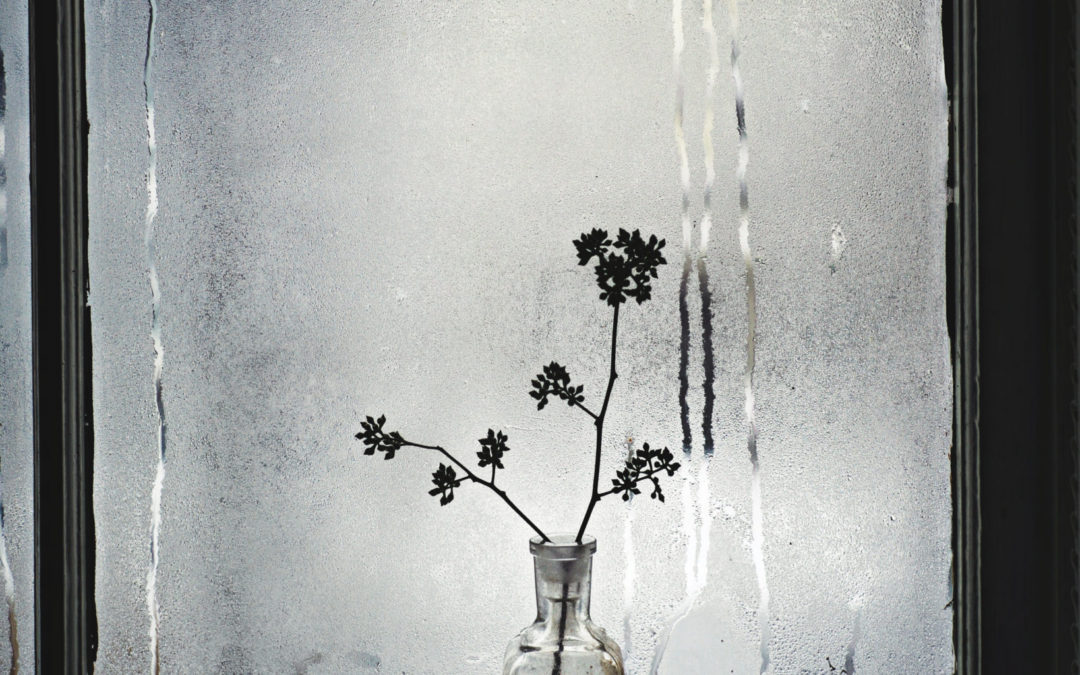
by Grryo Community | Feb 17, 2017 | Anne Closuit Eisenhart, Still Life, Stories, You Are Grryo
I remember, as a child, fumbling in the complete darkness of my bedroom. The clock having just struck my morning anxieties, and myself heading toward the window to summon the day into the room. Rolling up the night around the slats of the blind, the picture of the wakening day gradually unfolding before me. I usually paid little attention to it. A glimpse that made me feel both reassured that the world was still out there, and worried my school was too.

Some mornings had a different feel though. As soon as a glimmer of daylight crept into the dark, I already knew at its particular brightness that the day would hold different promises. It had snowed and perhaps it might keep snowing!

When I reminisce over the snow days of my childhood, I cannot single out or describe this or that particular day with its own distinct facts. Yet alive in me are a set of moments spreading from this time, grouped in my mind by a similar naïve joy, etched with such emotion that my memory has decided to gather them into one souvenir.

And I can see myself, pulling a chair by the window and watching the snow come down slowly over the wet plain, settling silently in the hollows, on the roofs, seizing the roads and the alleys, covering the ugliness brought on by the day. Then, having made everything even, everything level, it is forced to accept it must fall on itself. At this point, one’s attention is no longer drawn to anything and ceases to recognize. And now one can only see one’s own images projected on the white screen offered by the winter.

Or, I was outside. Snow had stopped and I was trying to identify parts of the scenery, my playground, my bicycle under a bump. And it was like attempting to read a book in a foreign language, familiar enough to follow the story line, yet not the details.
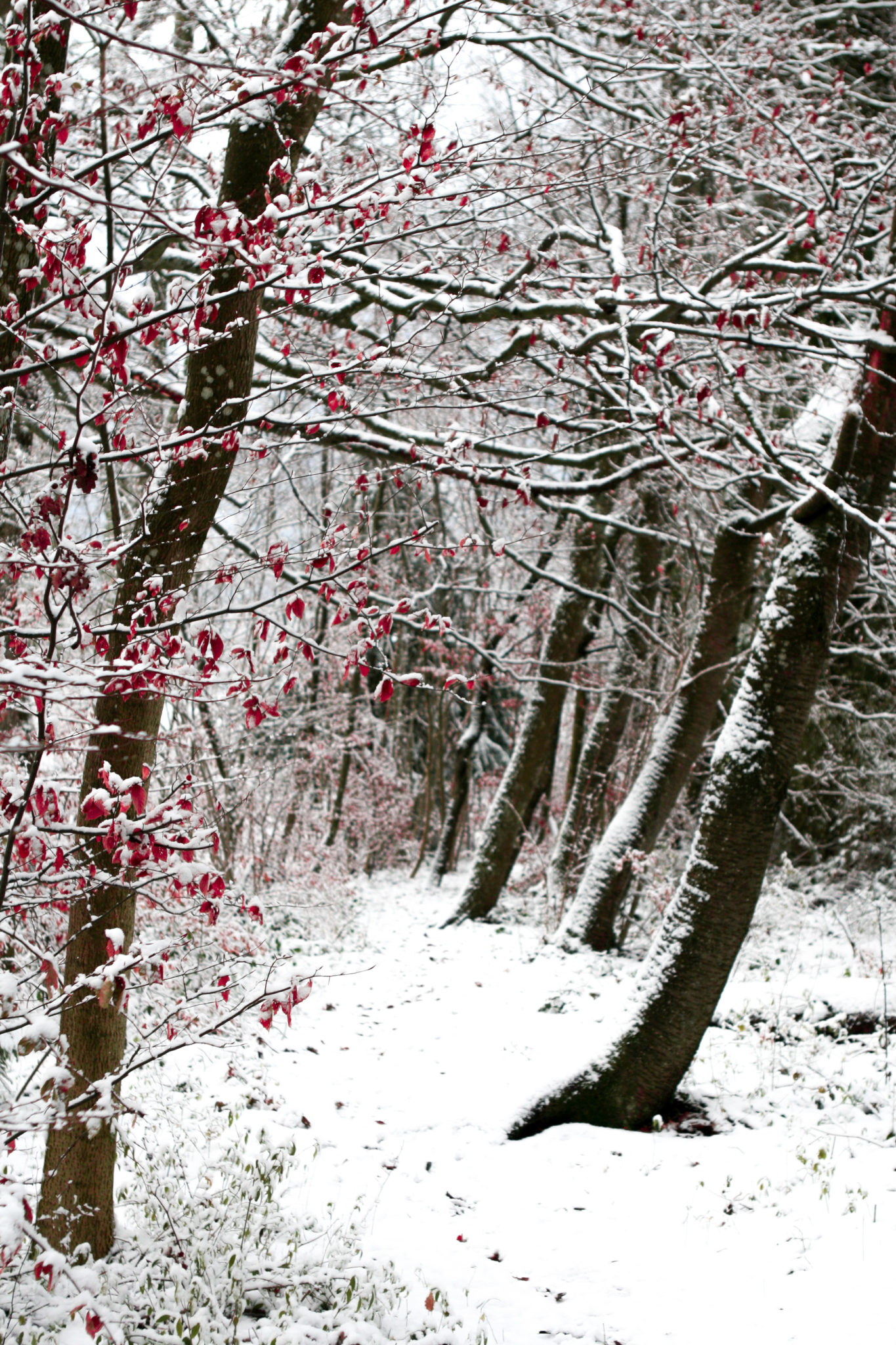
To this day, I prefer winter to any other season. Not only the snow, but the cold that enlivens or numbs. The fury of the wind when it blows the leaves off and gives them back to the earth, which later chews them and gobbles them up. I enjoy this harshness and this severity. People meet and get to the essential, because it is too cold to linger and tell more.

I enjoy the monotonous landscape. The nature when it depletes, gathers itself, and mourns. The ground that is brown then grey then white then dirty. The flight of the birds that is shorter and heavier. The way they suddenly flock into bands, ruffle the trees and the electrical cables. The ones that decide to remain lonely.

I enjoy watching the night as it awakens the day with the city lights turning on one by one like fireflies on a summer night. The shadows are longer, more present in the home. Our lives languish, it is a slower time, allowing us to look backward. As when walking in the snow, we have to stop and turn around in order to see our own tracks.

And last, I enjoy winter when it shies away, out of breath, and suddenly gives way to perpetual renewal, to the sweet illusion we call Spring.
Anne Closuit Eisenhart is @lesfifoles on Instagram
Ode à l’Hiver – Par Anne Closuit Eisenhart
Je me revois, enfant, avancer à tâtons dans le noir de ma chambre. Le réveil venait de sonner mes angoisses matinales et je me dirigeais vers la fenêtre pour convoquer l’aube dans la pièce. Tandis que j’enroulais la nuit autour des lamelles de mon store, se déroulait à mesure devant moi le tableau du jour qui s’éveillait. Je n’y prêtais d’habitude aucune attention particulière. Tout juste un regard qui me rassurait car le monde était toujours là, et qui m’inquiétait car mon école aussi.
Certains matins, il en allait différemment. A peine un rai de jour se glissait-il dans l’obscurité que je savais déjà, à l’éclat spécifique de la lumière, que la journée tiendrait d’autres promesses. Il avait neigé et peut-être neigeait-il encore…
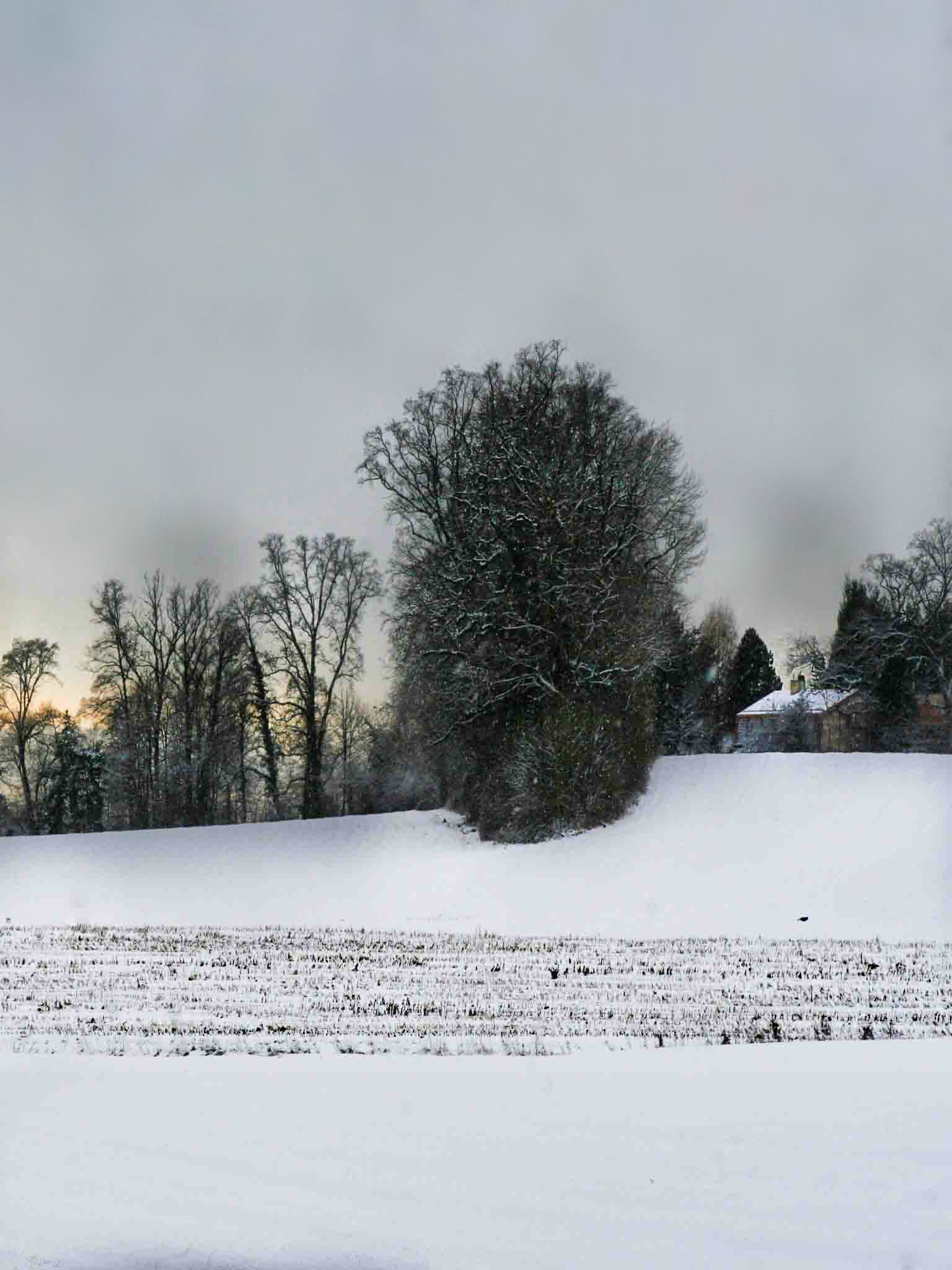
Quand je me remémore les jours de neige de mon enfance, je ne peux bien sûr pas décrire telle ou telle journée précise avec ses faits bien à elle. Mais continue de vivre pourtant en moi un ensemble de moments s’étalant dans ce temps, regroupés dans mon esprit par une même joie naïve, inscrits avec suffisamment d’émotion pour que ma mémoire décidât de les réunir en un souvenir.
Et je peux me voir, tirer la chaise près de la fenêtre et regarder la neige descendre lentement sur la plaine humide, s’installer, silencieuse, dans les creux, sur les toits, s’emparer des routes et des chemins, recouvrir la laideur amenée par le jour. Puis, quand elle a rendu tout égal, quand elle a tout nivelé, se résoudre à tomber sur elle-même. Alors le regard n’est plus arrêté par rien et cesse de reconnaître. Et l’on ne fait plus que voir ses propres images intérieures se projeter sur l’écran blanc que nous offre l’hiver.
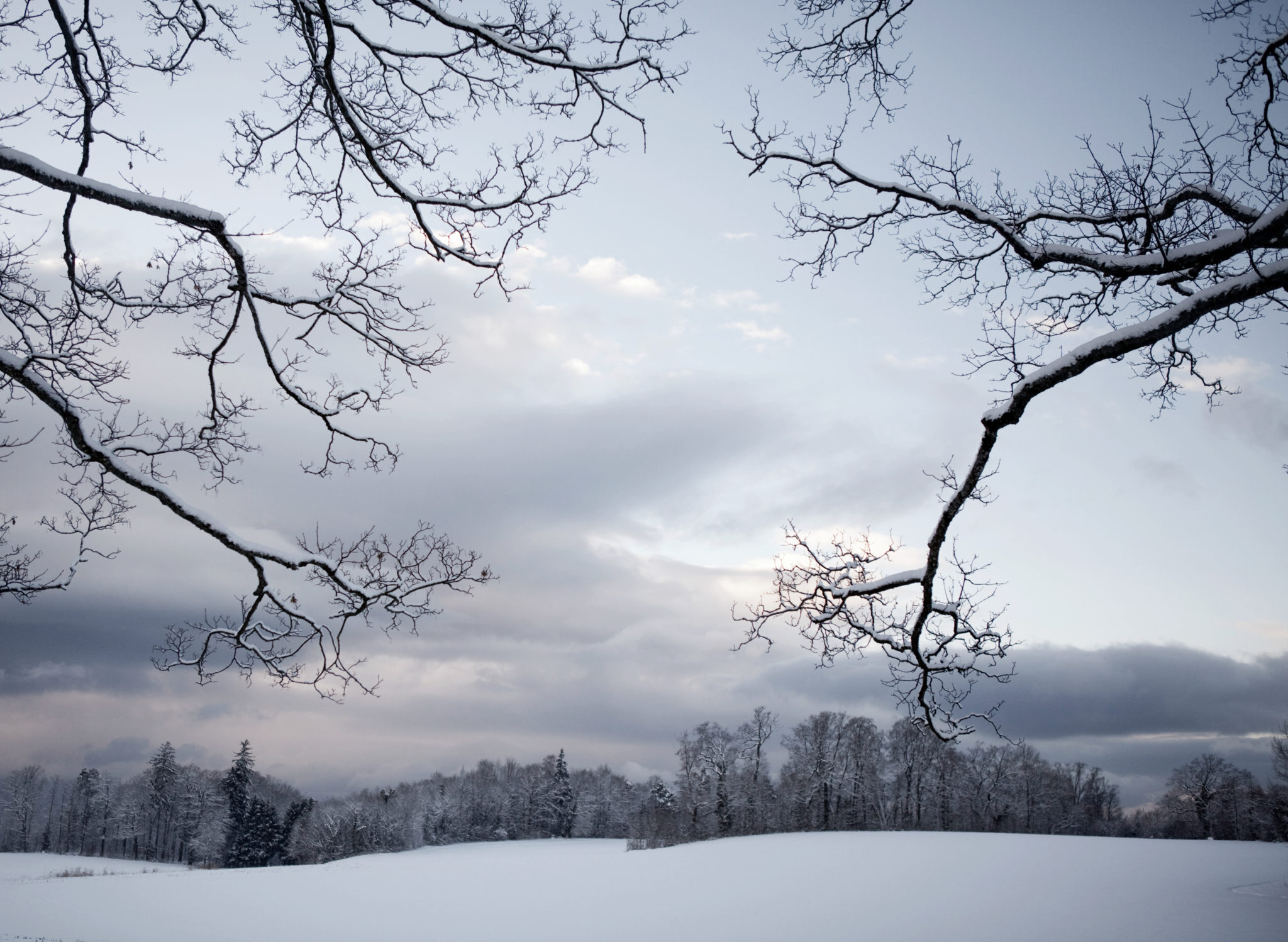
Ou encore, j’étais dehors, il avait cessé de neiger et j’essayais d’identifier le paysage, mon terrain de jeux, mon vélo sous une bosse. Et c’était comme tenter de lire un texte dans une langue étrangère suffisamment familière pour qu’on en comprenne la trame pas assez cependant pour qu’on en saisisse tous les détails.
Aujourd’hui encore, je préfère l’hiver à n’importe quelle autre saison. Pas seulement la neige, mais aussi le froid qui vivifie ou engourdit, la fureur du vent qui arrache les feuilles des arbres et les rend à la terre qui les mâche puis les engloutit. J’aime cette rudesse, cette âpreté. Les gens se croisent et se disent l’essentiel car il fait trop froid pour en rajouter.
J’aime le paysage monotone. La nature qui se dépouille et se recueille. La terre brune puis grise puis blanche puis sale. Le vol des oiseaux qui est plus lourd et plus court. Cette façon qu ‘ils ont soudainement de se mettre en bandes, d’hérisser les arbres, les fils électriques. Ceux qui décident de rester solitaires.
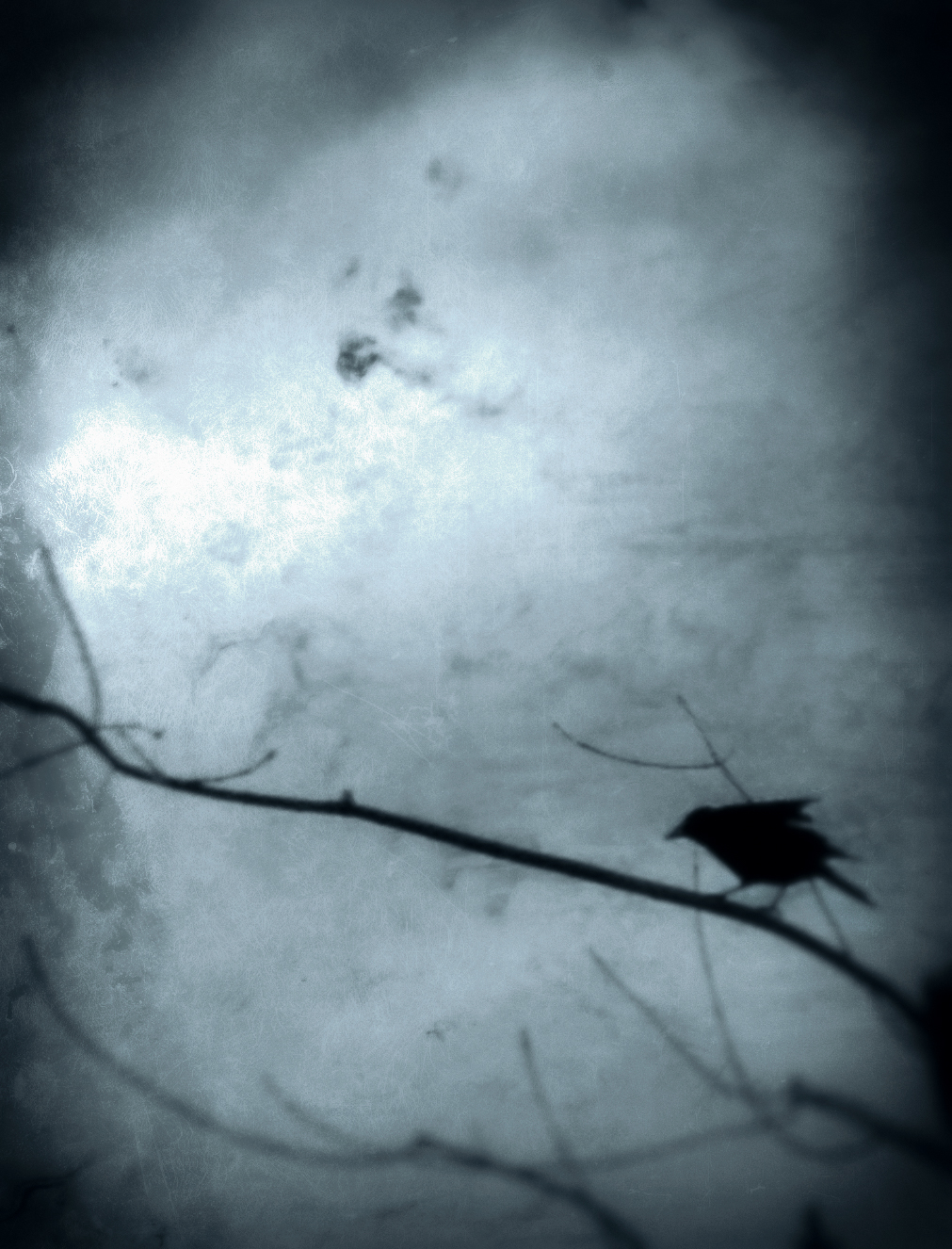
J’aime guetter la nuit quand elle réveille le jour, et regarder les lumières de la ville s’allumer une à une comme des lucioles un soir d’été. Les ombres sont plus longues, plus présentes dans la maison. Nos vies se traînent, c’est un temps plus lent, fait pour regarder en arrière.C’est comme quand l’on marche dans la neige, il faut s’arrêter et se retourner pour voir ses pas.
J’aime enfin l’hiver quand il se dérobe et, à bout de souffle, cède la place à l’éternel recommencement, à la douce illusion qu’est le printemps.
Anne Closuit Eisenhart est @lesfifoles sur Instagram

by Grryo Community | Dec 22, 2016 | Still Life, Stories, You Are Grryo
Thinking back on my childhood, I realize photography has always been part of my family. As I was growing up, my father was often taking pictures. I remember the excitement when he brought back the developed images that we all gathered to look at. My mother was in charge of sorting and creating albums that we later enjoyed looking through while talking about the memories. Through my early years, I had access to different kinds of Instamatic cameras. When I entered high school I inherited my older brother’s Minolta SLR when he bought a newer one. That became my first camera.

During my 20s, I became an avid traveler, and while spending a few days in Hong Kong, I invested in a manual Nikon FM2. I started to create visual diaries of my travels. I was shooting mostly in color, not just the obvious sights of interest; but rather, everything including people, food, landscapes and detailed architecture. Inspired by travel magazines, I would create photo scrapbooks upon my return home, and photo albums with added “tokens” (i.e. admission tickets, menus, travel documents) and occasional short stories.


‘Untitled Cabaret DR’
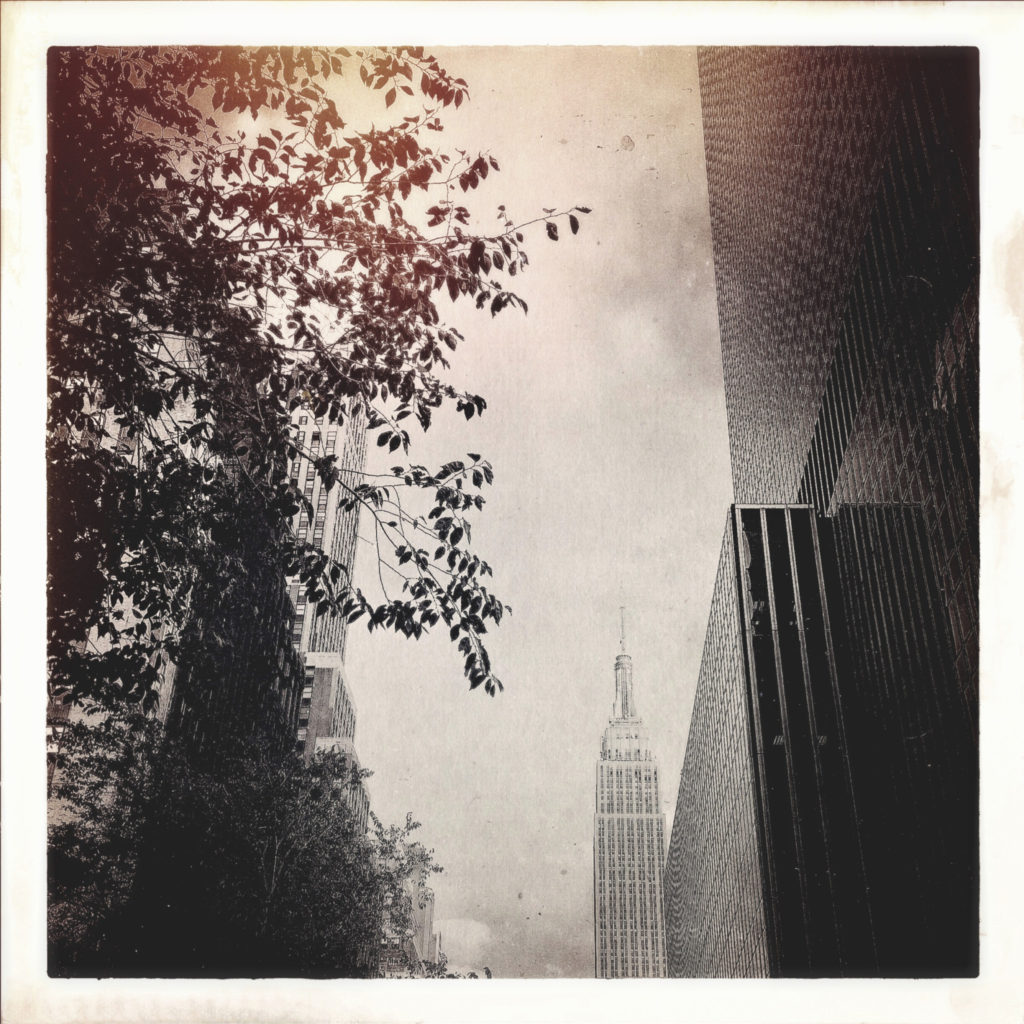
‘Where Dreams Are Made Up’
In my later 20s, I completed my first photography course, “Beginners B/W Developing and Printing”. A couple of years later, my husband landed a job in New York and we made the move. As a stay at home mom, I would take occasional trips into the big city …and what a city!
I continued to take B/W printing classes as well as lighting, and a couple of portrait classes at ICP (International Center of Photography). It was an exciting time. I felt it was a true inspiration to be around other photographers and enthusiasts, feeding off their creativity. Unfortunately, it was very costly.
During this time I was exploring self-portraits as well as still life combined with some human form. Anybody that has done a series of self-portraits knows the time and hard work that goes into it. With this being said … I eventually wore out the time-release crank on my camera and decided to make an upgrade.
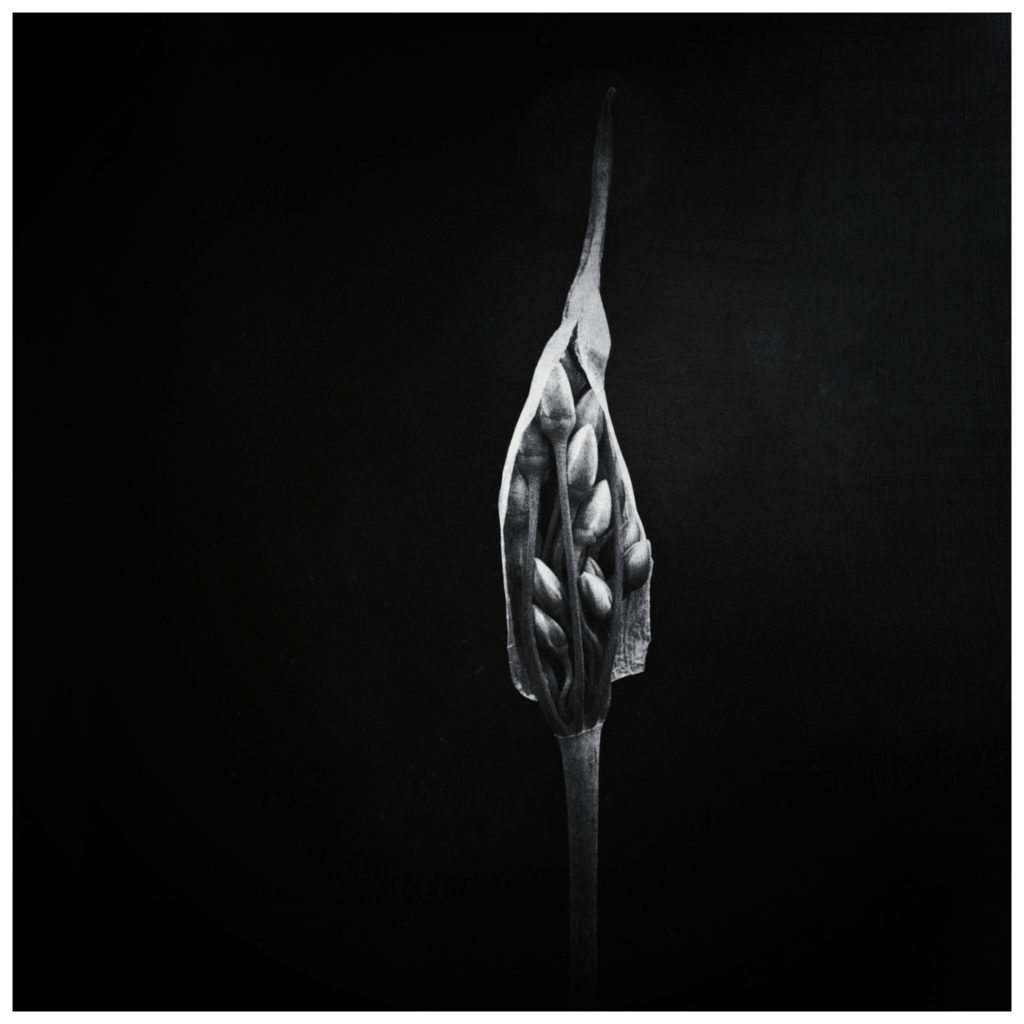

“Curled Up”
Just like many parents, I have taken numerous photos of my daughter as she was growing up. I began using Tri-X film, then slowly moving over to color film and eventually graduating into digital photography in 2006, when I bought a Nikon D300. By the time I got my digital camera, my daughter was already in high school and her interest in posing for me had diminished. Now she is 23, and I am lucky if I get one opportunity per year for a portrait session with her, although sometimes that is all it takes.


‘In sync’
Three years ago, I got my first smart phone. My interest for iPhone photography grew with easy access of availability to the phone. I started to explore a variety of editing apps, and found Hipstamatic to especially be a great tool in expressing what I wanted to capture in the beauty of nature. I shoot mainly in the comfort of my backyard, and other nearby surroundings.

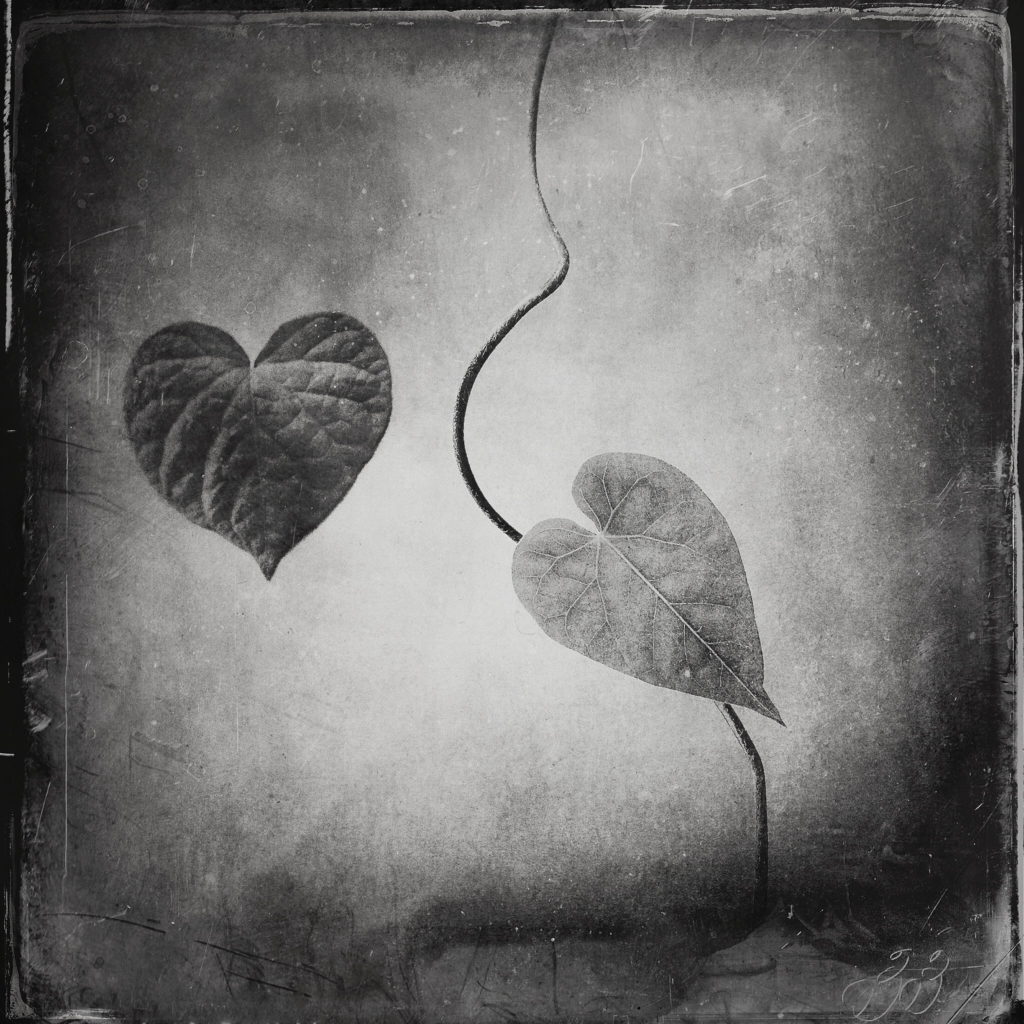
‘Flirtatious’
As much as I like portraits and the idea of shooting portraits, it’s challenging because my preference as a photographer is to study and explore as I work patiently with my subject. I find it difficult to focus on shooting while interacting with a model at the same time.
 ‘Bulb and Bottle’
‘Bulb and Bottle’

‘Bulb & Bottle #2’
When photographing nature, I allow myself time, and the process becomes a slow unfolding discovery of the object. Most often I shoot outdoors, incorporating the use of different papers as background to avoid clutter and to help isolate the object. I explore different angles, turning the object continuously trying to find the right perspective for my shot.
After throwing out a dying poinsettia this past winter, I discovered a tiny dry leaf that resembled an embryo left. I do believe in pre-visualizing images, but with phone photography, I work differently. For me it is important to have an open mind about what I am shooting. There are many variables when shooting outdoors in ambient light and therefore it will frustrate me if I can’t capture that image. I try to assess and from there let my creativity take over. If time and light allow, I shoot extensively. Better too many than too few, because I may not be able to do it over.
 ‘Interrupted’
‘Interrupted’
A couple of months ago I had some friends over, and one of my guests brought me a lovely flower arrangement with miniature daffodils. As they eventually wilted, its leaves and flowers turned a faint golden and were cascading over the glass brim in which it was planted. In what is clearly garbage to most, I saw photographic potential. After separating the bulbs and untangling the leaves, I ended up with a bulb that looked like someone with a “bad hair day.” Sitting on my back porch, I was shooting against a black cold pressed artist paper, exploring shapes, patterns, lights and shadows as they changed while I turned it around. Finally I chose a self-made spray-painted silvery background – the reflections at times gives the impression of me using a background spotlight. I think my choice of shooting in Hipstamatic Classic with the John S lens enhances this effect. I really like how the new improved Hipstamatic 300 allows me to adjust the shutter speeds. I rarely shoot in “A” (Automatic). Changing speeds manually gives me better control and I almost always use a software flash, to give the image a bit of “kick”. I strive to get as good of a negative as possible, to cut down on any post-process editing.
 ‘Barren’
‘Barren’
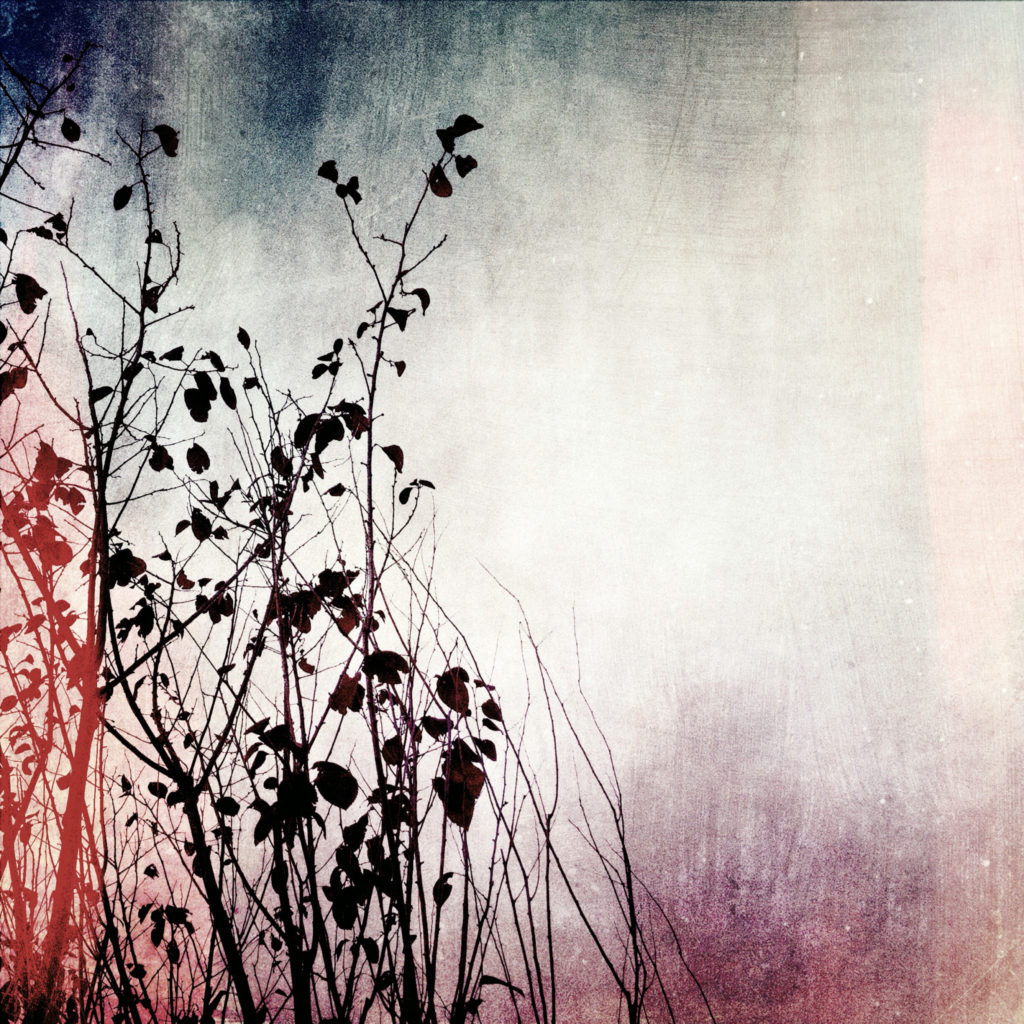
I try to convey moods, or bring out expressions interpreting feelings of my own at that moment, whether spontaneously or triggered by collected experiences and old memories. When looking through the viewfinder, I see natures’ little secrets unfolding, and these discoveries make me feel very special and truly grateful to be able to recognize them. I often get so intrigued that I lose track of time.
 ‘Journey’
‘Journey’
You can find more of my work on Instagram as Swash63.
Susanne was born 1963 in Luleå, Sweden. Married and we have one daughter. After Highschool she went on to an education in “Sewing and Design”. She have worked various jobs including as a photo assistant. Moved to New York in 1997. She has taken several photo courses at ICP (International Center of Photography) incl. Bnw printing, lighting, portraiture and alternative processes. Currently, she works as a manager in an Outerwear Boutique.

by Grryo Community | Aug 31, 2016 | Anne Closuit Eisenhart, Still Life, Stories, You Are Grryo
“I should perhaps make it clear that in speaking of love of the past, what I really mean is love of life, for there is so much more of life in the past than in the present. The present is of necessity but a fleeting moment, even when the fullness of that moment makes it seem eternal. When one loves life, one loves the past, because the past is present insofar as it survives in human memory.”
― Marguerite Yourcenar
I have never had any grandparents other than in the first pages of the family album, right before my parents’ wedding photographs. Among the dated portraits from that gallery, there is one I know better than the others. It is the sepia picture of a young lady wearing a black velvet hat: my grandmother, who passed away when my father was 4 years old. He could only keep memories of her, indistinct as shadows, and never talked about the unfillable void her death had left. On my part, as far as I can remember, I have secretly carried inside me what I was fancying as his pain, certainly mixed with my own anxiety of losing my parents. I have questioned time and time again this photograph without a legend. And the album gets heavier and heavier with each time I put it back on the shelf.
It was my first contact with photography. It taught me, what would be for me, the essence of it. That a photograph is a guardian of memory, that it is the fabric on which one can embroider one’s own story, and yet that it is also a kind of lie, as it tells of a present that no more exists.
I have in me an artistic sensibility that was all along thwarted by ten clumsy fingers. Therefore, I worked to develop my artist’s eye by studying the history of art. I learned to recognize what I liked, as I could not create it. I intuitively integrated many compositional rules. But mainly I understood the importance of light; how light can ennoble everything, even the vulgar.
I photograph essentially still lifes and landscapes. Since the birth of my children, I hunt through flea markets looking for a patrimony I did not receive, but would like to pass on to them. I always bring back the same treasures: mildewed mirrors, bottles with the glass turning opaque, moth-eaten cuddly toys, shattered vases glued back together, old drawers. Simple objects with no particular style, that have survived over the years, bearing the signs that they were useful and that they were loved.

I never know in advance what my next photograph will be. I pick objects, a flower languid in a vase, and I nudge them into a relationship. I make them talk to each other. I place them a certain way and then another. I circle around. I wait for the right light. I try to create a tension or a harmony. I am not looking to establish a symbolic meaning, just a visual emotion that moves me and that maybe will touch somebody else as well.
It is the same thing when I photograph landscapes. I am not interested by the picturesque aspects. Most of the time they are familiar places and I have previously charged them with emotion. Excess details that merely distract are often erased by mist, by night, or by speed when taking pictures in the car. I wander and suddenly something calls me, something I can relate to, something I recognize. This is precisely what I try to capture in my photographs. And if that feeling is not present enough when I develop the pictures, I heighten or diminish the light, I play with contrasts, I add dust or scratch here and there, in order to find back my initial vision.
Surely my photographs speak about another time. A time that is not today. A time when one took one’s time. When one valued the sustainability of things. When the world didn’t feel so big.These are nostalgic photographs. Namely they are bearers of memory. Witnesses at the same time of permanence and of fragility.One does not escape one’s own story.
Anne Closuit Eisenhart is @lesfifoles on Instagram
Photographie et Mémoire – par Anne Closuit Eisenhart
“Quand on parle de l’amour du passé, il faut faire attention, c’est de l’amour de la vie qu’il s’agit; la vie est beaucoup plus au passé qu’au présent. Le présent est un moment trop court et cela même quand sa plénitude le fait paraitre éternel. Quand on aime la vie, on aime le passé parce que c’est le présent tel qu’il a survécu dans la mémoire humaine.” – Marguerite Yourcenar
Je n’ai jamais eu de grand-parents ailleurs que dans la première page de l’album familial, juste avant les photographies du mariage de mes parents. Dans cette galerie de portraits démodés, il en est un que je connais mieux que les autres. C’est l’image sépia d’une jeune femme avec un chapeau en velours noir : ma grand-mère, morte quand mon père avait quatre ans. Il n’en gardait comme mémoire que quelques ombres et ne mentionnait jamais le vide qu’elle avait laissé. Moi, d’aussi loin que je m’en souvienne, j’ai porté secrètement ce que je m’imaginais être sa souffrance avec sans doute aussi la peur de perdre mes parents. Cette photographie sans légende, je l’ai questionnée à maintes reprises. Et à chaque fois que je replaçais l’album sur l’étagère, il pesait un peu plus lourd.

Ce fut mon premier rapport avec la photographie et j’y ai appris l’essentiel. Qu’une photo est gardienne de mémoire, qu’elle est un tissu sur lequel chacun peut broder sa propre histoire et qu’elle ment aussi un peu car elle dit un présent qui n’existe plus.
J’ai en moi une sensibilité artistique que depuis toujours dix doigts malhabiles s’acharnent à contrarier. Alors je me suis faite un oeil en étudiant l’histoire de l’art. J’ai appris à reconnaître ce que j’aimais à défaut de pouvoir le créer. J’ai emmagasiné intuitivement certaines règles de composition. J’ai surtout compris l’importance de la lumière, comment elle peut tout anoblir, même le vulgaire.

Je photographie essentiellement des natures mortes et des paysages. Depuis la naissance de mes enfants, je parcours les brocantes à la recherche d’un patrimoine que je n’ai pas reçu et que je veux leur transmettre. Je rapporte toujours les mêmes trésors : des miroirs piqués, des bouteilles au verre devenant opaque, des peluches mitées, des vases recollés, de vieux tiroirs. Des objets simples, sans style particulier, qui ont survécu aux années et qui portent sur eux des signes qu’ils ont été utiles et qu’ils ont été aimés.
Je ne sais jamais à l’avance quelle photo je vais prendre. Je choisis un objet, une fleur qui traîne dans un vase et j’instaure entre eux une relation. Je les fait parler. Je les place, les déplace. Je tourne autour. J’attends la bonne lumière. J’essaie de créer une tension ou un accord. Je ne cherche pas à donner une dimension symbolique, juste à créer une émotion visuelle qui me touche et qui va peut-être toucher quelqu’un d’autre.

C’est la même chose quand je photographie des paysages. Le pittoresque ne m’intéresse pas. La plupart du temps ce sont des lieux qui me sont familiers et que j’ai déjà chargés d’émotions. Le surplus de détails qui distraient est souvent gommé par le brouillard ou alors par la vitesse quand je prends des photos en roulant. Je me promène et soudain il y a quelque chose qui m’appelle et fait écho en moi, quelque chose que je reconnais. Et c’est cela que j’essaie de photographier. Ensuite lors du développement, si ce sentiment initial n’est pas assez présent, je pousse certaines lumières, je joue avec les contrastes, j’ajoute quelques taches pour accentuer ma vision initiale.
Sans doute mes photographies parlent-elles d’un autre temps. D’un temps qui n’est pas aujourd’hui. D’un temps, où l’on prenait son temps. Quand on valorisait la durabilité des choses. Quand le monde n’était pas si grand.
Ce sont des photos nostalgiques. C’est à dire porteuses de mémoire. Témoins à la fois de permanence et de vulnérabilité.
On n’échappe pas à sa propre histoire.





















































